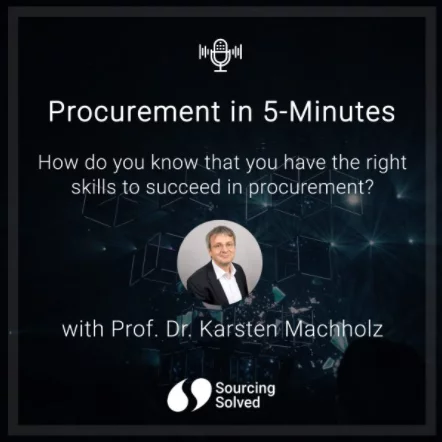Are the Procurement Labs developing the desperately sought-after C-19 business vaccine for strengthening the immune systems of our economy and our businesses?
The Covid-19 pandemic has moved procurement into the spotlight. Politicians and business leaders alike, placed significant attention on procurement and supply chain management when it comes to alleviating the pandemic’s economic and commercial impacts. Globally, governments got involved in securing supply of respiratory equipment and masks. Top management across all industry sectors rolled up their sleeves to help securing raw materials and components for their production to not come to a standstill. Now, that the laboratories of BioNTech / Pfizer and Moderna have announced a breakthrough with their C-19 vaccines, the governments globally again get involved in securing the supply of sufficient doses for their countries’ population.
The most recent (September 2020), second edition of the Bertelsmann Foundation’s megatrend report illuminates how the pandemic is slowing down globalization and is accelerating digitalization.
- The international division of labor is coming increasingly under pressure
- Where previously efficiency and cost minimization have been the decisive aspects in shaping the international division of labor, the post-pandemic new normal will much more focus on the question of continuity of supply, solidarity and sustainability
- There is already a first tendency of re-shoring production capacity to avoid dependencies on certain geographies or countries
- The use of digital technologies will continue to accelerate and will reduce the risk for companies to be exposed to immediate risks and issues such as sickness related shortages of supply from specifically impacted geographies and industries
These conclusions and specifically the value chain aspect of globalization clearly emphasize the importance of procurement in finding an effective medication from an economic and business perspective.
Can the Procurement Labs develop the desperately sought-after BNT162b2 or mRNA-1273 business equivalent?
To a certain degree procurement can. Of course, procurement will not stop the spreading of the virus and procurement cannot directly prevent or tackle the decline in demand, buying power and top-line revenues. However, procurement can
- play a much more prominent role in creating business resilience
- play a decisive role in strengthening a company’s immune system
- be the vaccine preventing symptoms like shortage of supply or disrupted value chains, unprofitable value constellations or ineffective and inefficient supply networks
However, procurement must reinvent itself to take on a new role and to avoid heavy side effects.
The new normal: The future role of procurement is being the powerhouse of information and the ecosystem orchestrator
Already before the world even thought about Covid-19, it was undergoing rapid disruption. In addition to globalization and digitalization, we have seen a variety of disruptors across all industries sectors, turning our world, our economies and our businesses upside-down: climate change, renewable energy, e-mobility, artificial intelligence, autonomous driving, flying taxis, amazonization together with omni-channel sales and fulfillment, Industrie 4.0 and the Internet of Things, etc.
Irrespective of being a global blue chip, a mid-sized regional or a small-sized local player, businesses needed to respond to these challenges with new or at least revised strategies and business models, for example the numerous variations of platform business models.
Back then – before Covid-19 – procurement was already seeing an upgrade in the companies’ pecking order. It was up to procurement to enable these new business models and already then procurement needed to change its focus. It was much more about scouting for innovation and innovators, buying new content, such as digital content and it was about buying from new sources of supply rather than the long-established supply base. start-ups and ecosystems started playing a vital role, not only changing processes and procedures but also changing behavioral patterns and the ways of working, allowing for agility and adopting a failing forward attitude. Procurement moved much closer to the companies’ core business to effectively enable the new business models. Procurement established innovation hubs and incubators for start-ups and scale-ups to leverage its business eco-systems.
And of course, already then, digitalization was playing an important part. More and more, operational and tactical procurement, i.e. the purchase-to-pay and source-to-contract processes got digitized and, in some advanced cases, even digitalized. Already back then, it became clear that procurement would need a new role in the future, as P2P and S2C technology in combination with robotic process automation and chat-bots, artificial intelligence and advanced analytics would replace this kind or procurement work or would shift the job towards the business owners.
Covid-19 has brutally revealed that those companies that had already started the digital transformation of procurement, could much better deal with the economic consequences of the pandemic than those companies which were lacking transparency due to missing data points. Data and transparency are ultimately allowing for business insight and business foresight, scenario modelling and effective strategic decision making.
Decelerated globalization is accelerating digitalization
Clearly, Covid-19 has further accelerated this transformation towards ecosystem or value chain orchestration. As the Bertelsmann Report explains: the globalization is slowing down. But by no means, does this imply that the value chain and business ecosystems will be easier to manage. The opposite is the case: we will still see global division of labor. It must and will remain for competitive cost and pricing reasons. However, at the same time, we will see local or regional dual or second sources to avoid the dependency on higher risk sources. Hence, the need for even more transparency and even more sophisticated scenario modelling increases. The various possible value chain configurations imply different value set-ups and value is not as simple as cost and risk only. It must comprise many more aspects, such as end-customer value, net promoter scores, time-to-market, innovation power and agility as well as resilience and sustainability in all its facets.
The currency in procurement will change from savings to business insight & business foresight, i.e. towards delivering the key intelligence to make better strategic corporate decisions. Procurement is the function with the most interfaces within every business. Internal, cross-functional interfaces, such as R&D, Finance, Operations, Sales & Marketing as well as external interfaces with suppliers, analysts, banks, academia, advisors, IT providers etc. This role as the spider-in-the-web is determining the future role of procurement as the powerhouse of information and the ecosystem orchestrator. No other function has a more immediate access to more relevant data and information than procurement.
RIP Category Management – Procurement must think beyond category
All this requires a much stronger strategic angle and a much deeper integration into the core business. The strategic procurement capability, also known as category management, is the starting point for procurement’s new role. However, traditional category management is not good enough, category management is a procurement perspective only. Nobody else in the business thinks in categories. Except for the retail industry, in which category is an end-to-end perspective, no industry sector structures its core business around procurement categories. Categories are used by procurement to allow demand aggregation and bundling. This is specifically true for indirect spend, but also for direct spend – for example if a raw material or component is bought for various business units. Therefore category management is a means for driving savings.
More advanced CPOs and buyers are sharing with us that they do not care about categories any longer. This is because the declining focus on savings. In order to be a valued and respected business partner, it is essential for procurement to think beyond category – to think in the same dimensions the core business does – to think in the same dimension the customer does. It is mandatory to deliver a much broader definition of value. What does beyond category mean? In automotive, procurement centers around the end product, i.e. a car or a platform or even around a mobility concept. In pharma, procurement centers around a blockbuster drug or a future integrated health solution. In construction or telecoms, procurement centers around a new technology such as 5G or an infrastructure project. There are many more examples and they all have in common, that procurement needs to also consider the entire life cycle of the category, product, project or service as well as its next evolution, e.g. from a car producer to a mobility provider.
Making procurement the business vaccine
The global race for an effective serum against the virus requires everything from the world’s leading virologists and biochemists. In the laboratories of BioNTech / Pfizer and Moderna, the experts have already achieved heroic status by working relentlessly and ultimately delivering the so much needed breakthrough innovation and reaching the most important milestone towards controlling the virus and defeating the pandemic.
Just like the pandemic itself, its economic impact on our businesses requires effective treatment. The scientists and pragmatists in the procurement labs can now elevate procurement to a heroic and truly strategic future. This requires developing the respective breakthrough capabilities for dealing with the new normal.
Still, the existing digital procurement solution landscape of operational P2P solutions and tactical S2C solutions as well as specialized procurement apps, such as digitized category strategy toolboxes and supplier scouting and relationship tools are rather accelerating the decline and elimination of procurement as we know it. It is the truly strategic procurement process beyond category which – once properly digitalized – will allow procurement to take on its new role.
Stay tuned…






